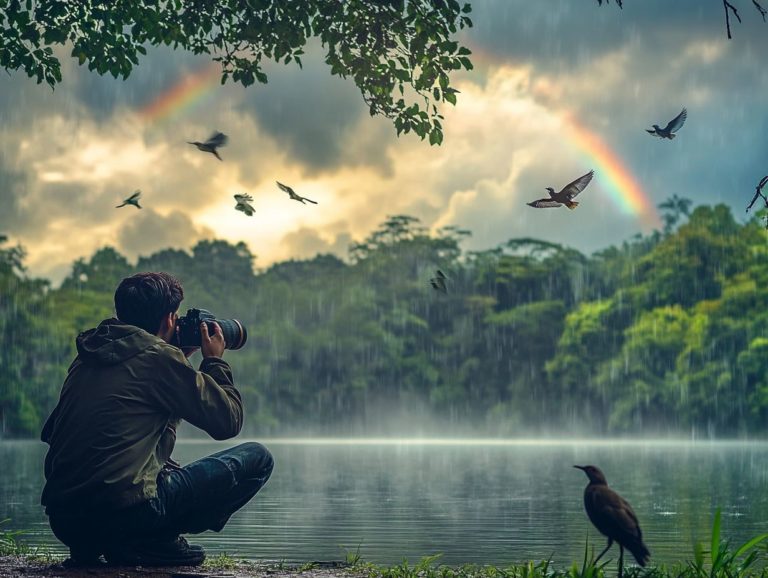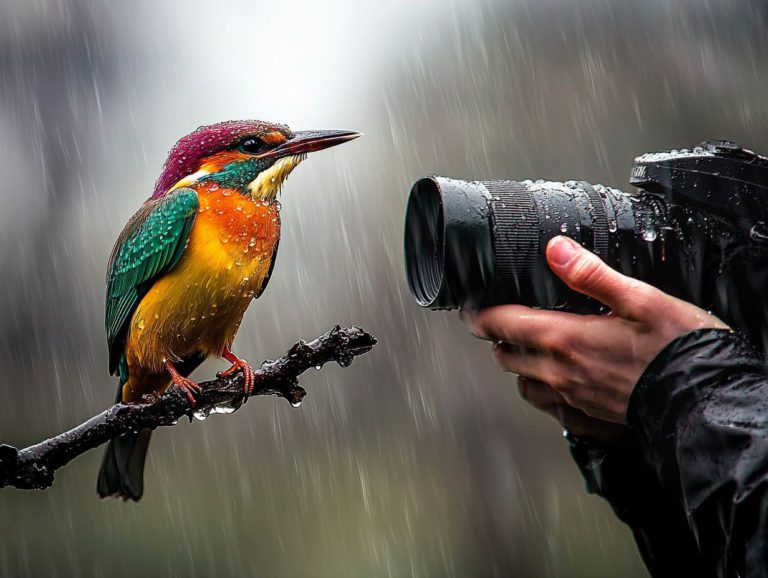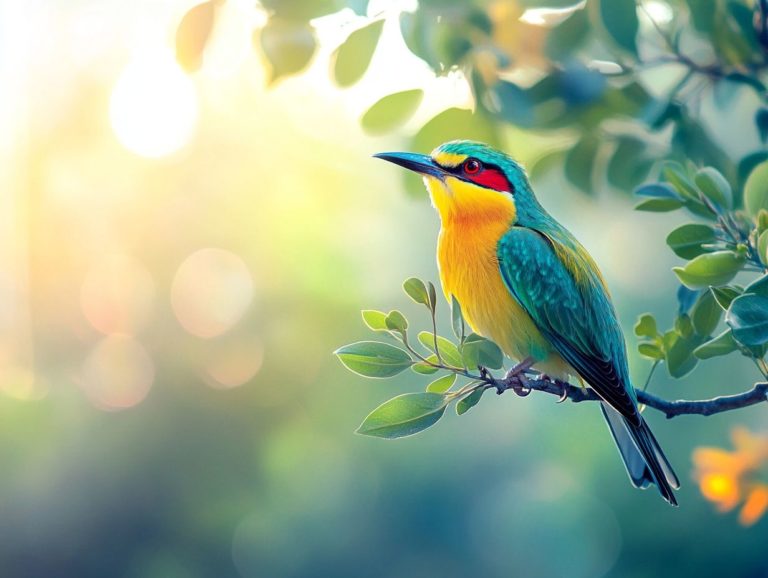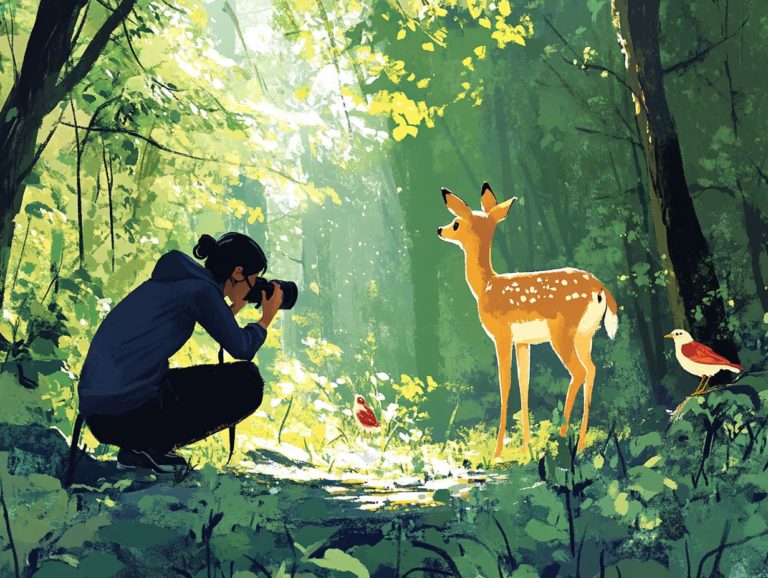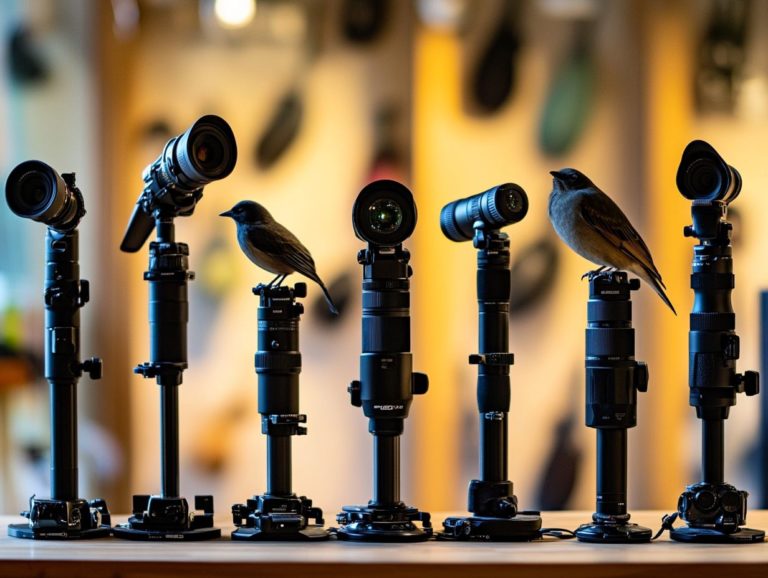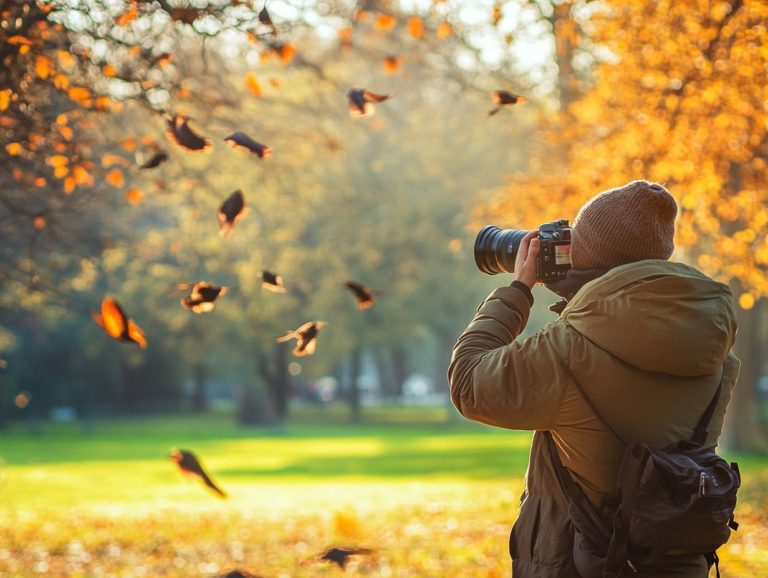Best Online Courses for Bird Photography
Bird photography, championed by renowned wildlife photographer Melissa Groo, is a captivating fusion of art and science. It provides a unique glimpse into the enchanting world of avian life.
Whether you’re an experienced outdoor photographer or just beginning your journey with a photography course, grasping bird behavior and mastering the right techniques can significantly enhance your skills. This guide will walk you through everything from selecting the ideal camera gear to capturing breathtaking images of birds in flight.
You ll delve into the nuances of photographic composition, lighting, and ethical approaches to engaging with your subjects in nature photography. Get ready to transform your bird photography into something extraordinary!
Contents
- Key Takeaways:
- 2. Understanding Bird Behavior and Bird Species
- 3. Choosing the Right Camera and Equipment
- 4. Mastering Camera Settings for Bird Photography
- 5. Composition and Framing Techniques
- 6. Lighting and Exposure for Bird Photography
- 7. Tips for Getting Close to Birds
- 8. Capturing Birds in Flight
- 9. Editing Bird Photos
- 10. Tips for Shooting in Different Weather Conditions
- 11. Best Locations for Bird Photography
- 12. Ethics and Safety in Bird Photography
- 13. Common Mistakes to Avoid in Bird Photography
- 14. Resources for Bird Photography
- Frequently Asked Questions (FAQs)
- What are the best online courses for bird photography?
- What skills can I learn from these online courses?
- How can these courses benefit beginners in bird photography?
- Are there any specialized courses for specific bird species?
- Do these courses offer any hands-on practice or feedback?
- Can I access these courses at any time?
Key Takeaways:
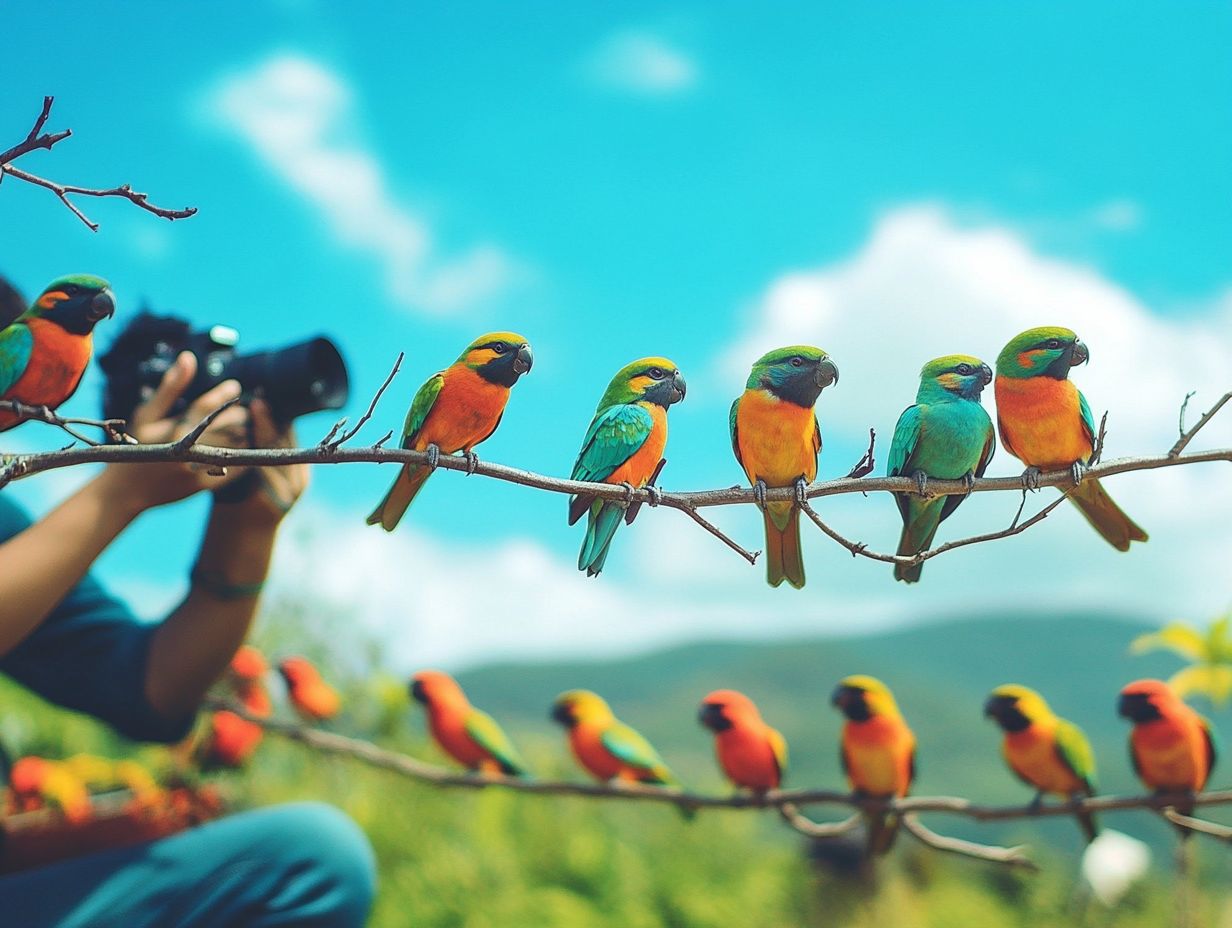
- Master the art of capturing stunning bird photos with the right camera settings and equipment.
- Learn how to understand bird behavior through fieldcraft techniques and get close to your subjects for unique shots.
- Enhance your bird photography skills with tips on composition, lighting, photo editing, and more.
2. Understanding Bird Behavior and Bird Species
Understanding bird behavior is essential for capturing stunning photos. It allows you to anticipate actions and interactions, particularly during critical moments like flight and feeding.
By observing patterns in mating rituals think about the intricate dance of courtship displays or the vibrant plumage that males flaunt to attract females you can position yourself for that perfect shot.
Recognizing specific feeding habits, such as how certain species forage for insects or dive for fish, enhances your chances of capturing dynamic images.
Learning about territorial displays, including vocalizations and posturing, allows you to predict when a bird might act defensively, leading to more engaging compositions.
By combining this knowledge of behaviors with identification techniques like noting size, coloration, and distinctive markings you can significantly improve your ability to anticipate those magical moments just waiting to be framed.
3. Choosing the Right Camera and Equipment
Choosing the right camera and equipment is crucial for any outdoor photographer looking to excel in bird photography. The right digital cameras and gear can truly make a significant difference in capturing fleeting moments that define this art form.
Explore your options wisely as you embark on your photography journey! Various camera models are specifically designed to capture the intricacies of avian life. You’ll find that digital cameras with interchangeable lenses stand out, especially when paired with long telephoto lenses that give you the necessary reach to zoom in on distant subjects.
Don t overlook the value of quality accessories. Sturdy tripods, remote shutter releases, and specialized bird photography bags can greatly enhance your shooting experience.
Many photography courses, including those offered by Bird Academy, emphasize the significance of selecting tailored gear. They guide you in assessing your personal preferences, shooting styles, and financial constraints. This ensures that your photography journey is not only enjoyable but also successful.
4. Mastering Camera Settings for Bird Photography
Mastering your camera settings is essential for capturing breathtaking photos in bird photography. The right adjustments can truly elevate your action shots, especially when you’re photographing birds in flight.
Understanding the interplay between ISO which controls your camera’s sensitivity to light shutter speed, and aperture is key to achieving outstanding results. For example, a high shutter speed is critical for freezing the rapid motion of a hummingbird’s wings, while a lower ISO can help minimize noise in more static scenes.
A wider aperture not only enhances light capture during those early morning shoots but also creates a lovely background blur that draws attention to your subject.
By experimenting with these settings, you can learn to optimize your camera for various conditions, ensuring that every shot is sharp and vivid even during the most exhilarating moments.
5. Composition and Framing Techniques
Effective photographic composition is essential for crafting captivating bird portraits. Thoughtful framing techniques can elevate your wildlife photography to remarkable heights.
By mastering various composition strategies, you can portray your subjects in ways that captivate viewers and weave a vivid narrative. The rule of thirds encourages you to position the bird in a balanced way that naturally guides the eye across the frame.
Leading lines direct the observer’s gaze toward the feathered subject or its surroundings, enriching the overall story.
Embracing negative space is another powerful technique. It allows the viewer to focus on the intricate details and behaviors of the bird while placing it within its habitat, creating a harmonious and impactful visual experience.
6. Lighting and Exposure for Bird Photography
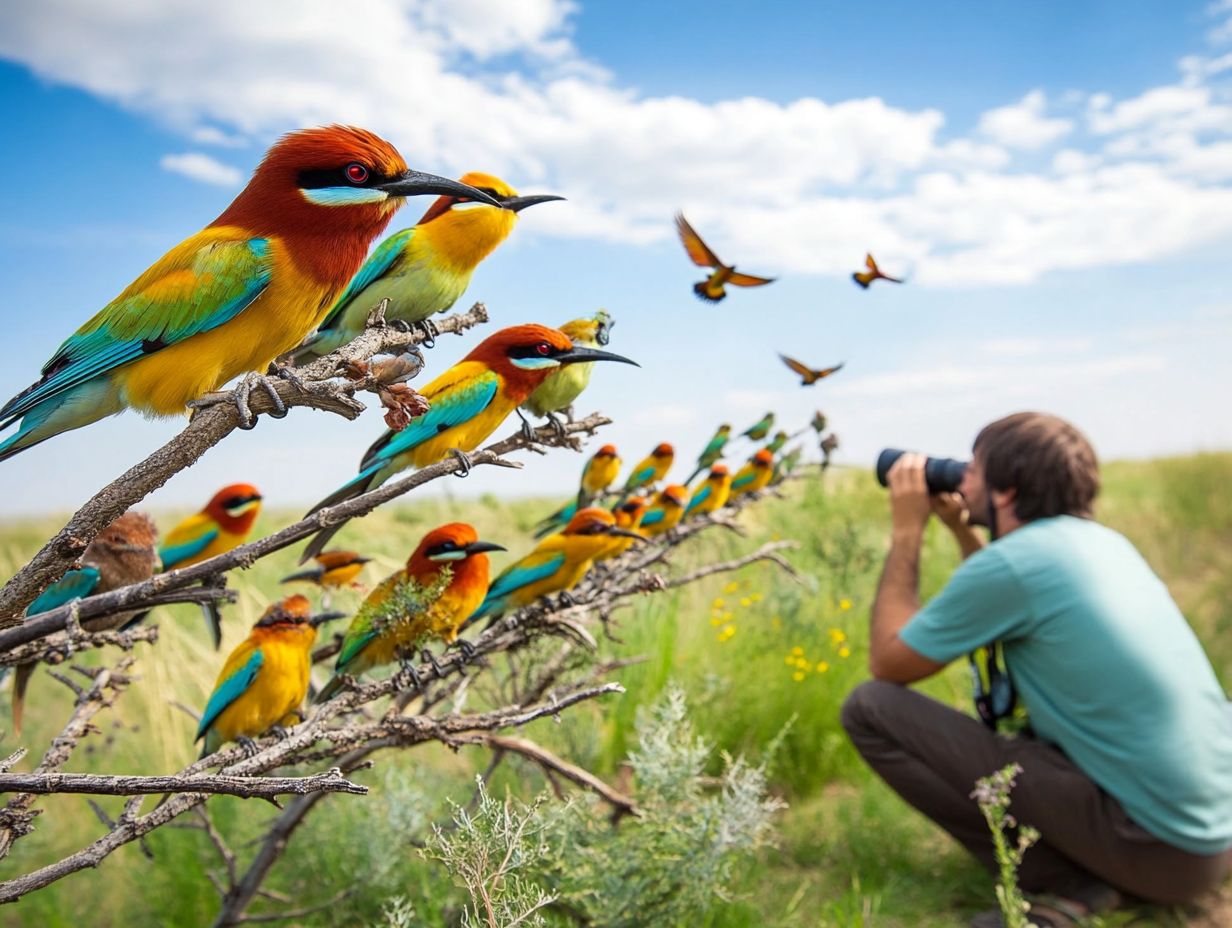
Mastering lighting and exposure is essential for outdoor photographers. The quality of light dramatically shapes the mood and clarity of your bird photography.
Throughout the day, natural light transitions from the soft, golden hues of dawn to the stark brightness of noon, and finally to the warm, diffused tones of twilight. Each phase presents unique challenges and opportunities for capturing feathered subjects.
In the early morning, the light is typically softer and more forgiving. It casts long shadows that can add depth to your images.
Backlighting during sunrise or sunset can create stunning silhouettes or radiant highlights around the bird’s feathers. Position yourself where that warm light spills through the wings or creates a halo effect.
Embrace the gentle light of the golden hours and strategically use backlighting. This will help you capture visually striking bird images that enhance both the aesthetic appeal and emotional resonance of your work.
7. Tips for Getting Close to Birds
Employing effective fieldcraft techniques is essential for outdoor photographers who wish to approach birds without disturbing them. This fosters a deeper connection with nature.
Learn how to move quietly and blend in. This will significantly enhance your chances of capturing stunning images.
Understanding the details of a bird’s territory like their feeding habits, nesting sites, and daily routines provides invaluable context for the best shooting positions.
Actively participating in the birding community allows you to share experiences and gain insights from seasoned photographers. These connections often reveal successful strategies that might otherwise remain hidden, enriching your birding experience.
8. Capturing Birds in Flight
Capturing birds in flight is one of the most exhilarating challenges you can face as a photographer. Getting this shot takes skill and the right camera settings!
Mastering techniques like panning and tracking can significantly elevate your images. Panning involves moving your camera in sync with the bird’s flight, creating a mesmerizing motion blur in the background while keeping your subject sharp.
Tracking focuses on anticipating the bird’s path. This allows for smoother, dynamic compositions that draw the eye.
Don’t underestimate the power of fast shutter speeds; they freeze the action and capture the intricate details of wings in motion. Settings like 1/1000th of a second or faster are recommended to catch every fleeting moment.
By experimenting with these techniques, you will create breathtaking visuals that convey the grace and agility of your avian subjects. Don’t miss those fleeting moments!
Grab your camera and head out during golden hour to capture stunning bird portraits!
9. Editing Bird Photos
Editing is essential in wildlife photography. It helps refine your creative ideas and enhances the impact of your bird images.
With tools like Adobe Lightroom and Photoshop, you can bring out the details and colors of your subjects while keeping their natural look intact.
Strike a balance between polish and realism. Subtle tweaks in shadows add depth, while careful color correction reveals vivid yet lifelike hues.
Experts recommend making specific changes to parts of the image to preserve the original essence. This ensures your final shot captivates while retaining its authentic charm.
10. Tips for Shooting in Different Weather Conditions
Shooting in different weather conditions presents unique challenges for outdoor photographers. Mastering the art of adaptation can elevate your wildlife photography to new heights.
Imagine exploring rainy days; they can create a moody atmosphere, with droplets adding magic to the beauty of flora and fauna. Fog imparts an ethereal quality, shrouding subjects in intriguing mystery.
Embrace these elements and experiment with your settings. Capture the inherent drama of each scenario.
Bright sunlight, when managed wisely, can illuminate your subjects beautifully. It casts dynamic shadows that add depth and character to your images.
Each condition brings its own distinct textures and lighting. This allows you to weave varied narratives through your lens and encourages you to explore both familiar techniques and new creative avenues.
11. Best Locations for Bird Photography
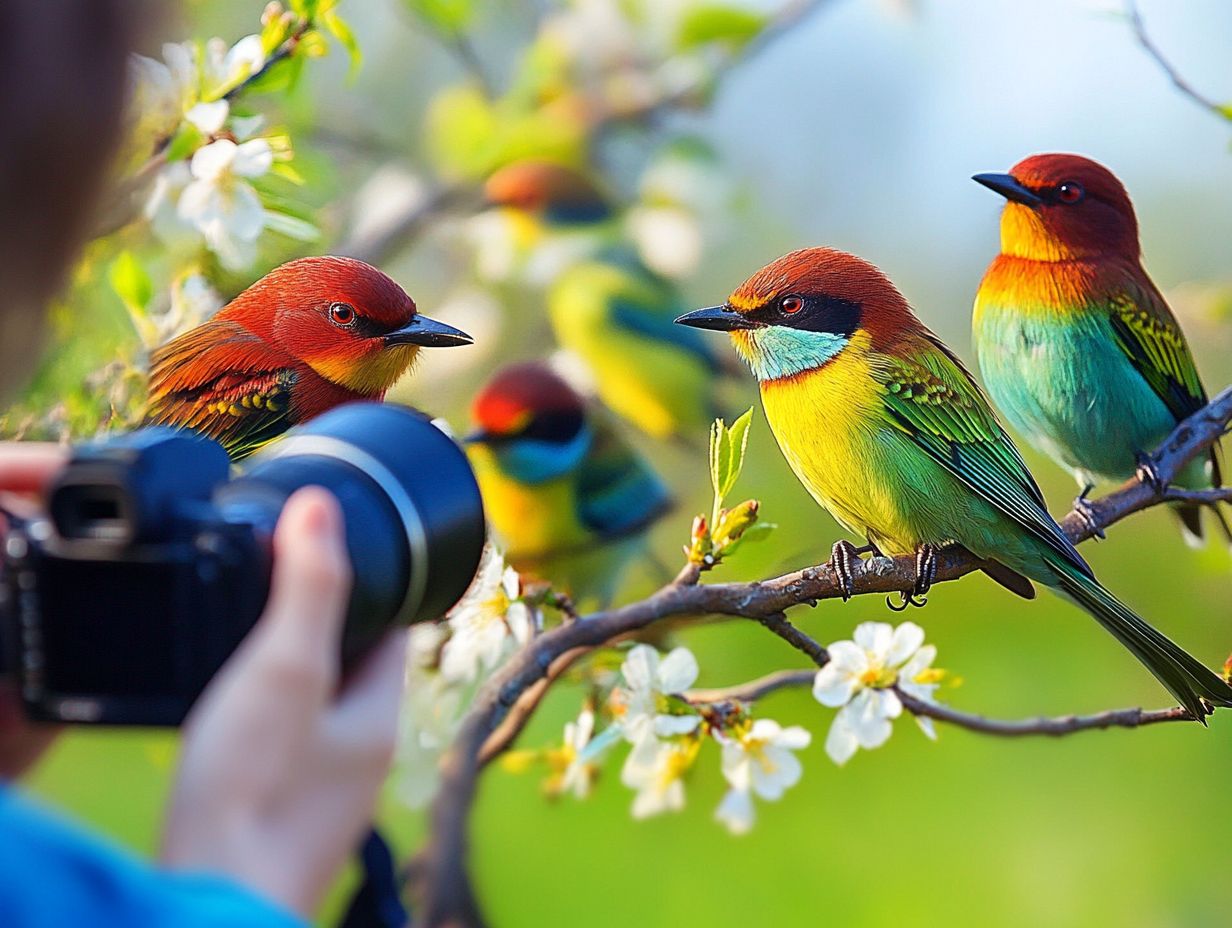
Finding the best locations for bird photography is crucial for any wildlife photographer. Certain habitats naturally draw in a variety of bird species, offering unique and captivating photographic opportunities.
Exploring national parks, wildlife reserves, and coastal wetlands can yield incredible results. You can capture everything from majestic raptors to vibrant songbirds.
Imagine wandering the winding trails of Everglades National Park or the tranquil lakes of Chesapeake Bay; these sites present diverse environments that cater to various avian species.
Engaging with the birding community can lead you to lesser-known spots teeming with colorful wildlife. This helps you uncover hidden gems that might not be on the usual radar.
By sharing experiences and tips, you can elevate your photography pursuits and deepen your understanding of local ecosystems.
12. Ethics and Safety in Bird Photography
Ethics and safety in bird photography are of utmost importance. They ensure that wildlife conservation principles are respected while capturing your subjects with care.
This responsibility means maintaining a safe distance from the avian wonders you seek to photograph. Be mindful of their habitats and surroundings.
Be aware of your impact on these environments. Steer clear of disturbances that could stress or disrupt the birds you admire.
The birding community plays a vital role in cultivating a culture of respect and awareness. They often organize workshops and discussions to emphasize the significance of ethical photography.
By partnering with conservation organizations, they not only raise awareness but also promote sustainable practices that benefit both wildlife and nature enthusiasts alike.
13. Common Mistakes to Avoid in Bird Photography
Avoiding common mistakes in bird photography can truly elevate the quality of your images, allowing your camera techniques and creative vision to shine at their best.
Many photographers tend to fall into recurring traps that can undermine their efforts. One prevalent issue is poor camera settings, like improper ISO (the sensitivity of your camera’s sensor to light) or shutter speed (how long the camera’s shutter remains open), which can fail to capture action or clarity. To remedy this, it s essential to familiarize yourself with your camera’s capabilities before you venture out.
Adjust those settings to accommodate fast-moving subjects. A lack of planning can often lead to missed opportunities. By scouting locations and timing your visits for optimal light and bird activity, you can vastly improve your chances of capturing stunning shots.
Not understanding bird behavior can result in missed moments or even startling your subjects. By studying their flight patterns and knowing their feeding habits, you ll set yourself up for a more successful and enjoyable photography experience.
14. Resources for Bird Photography
Accessing resources for bird photography, such as online courses and community groups, can significantly elevate your skills. For comprehensive insights, check out the top 10 bird photography resources online to deepen your understanding of this rewarding field.
These courses also include a wealth of books that cover everything from camera techniques to creative techniques, offering invaluable insights into how to get started with bird photography and capturing breathtaking avian images.
Local workshops present another exceptional opportunity, allowing you to gain hands-on experience while learning directly from seasoned photographers in your area.
Engaging with the birding community through these platforms is crucial, as it opens doors to networking opportunities and cultivates a collaborative atmosphere where both novice and experienced photographers can exchange tips, inspire each other, and even join in thrilling group outings to hone their craft in the beauty of nature.
Frequently Asked Questions (FAQs)
What are the best online courses for bird photography?
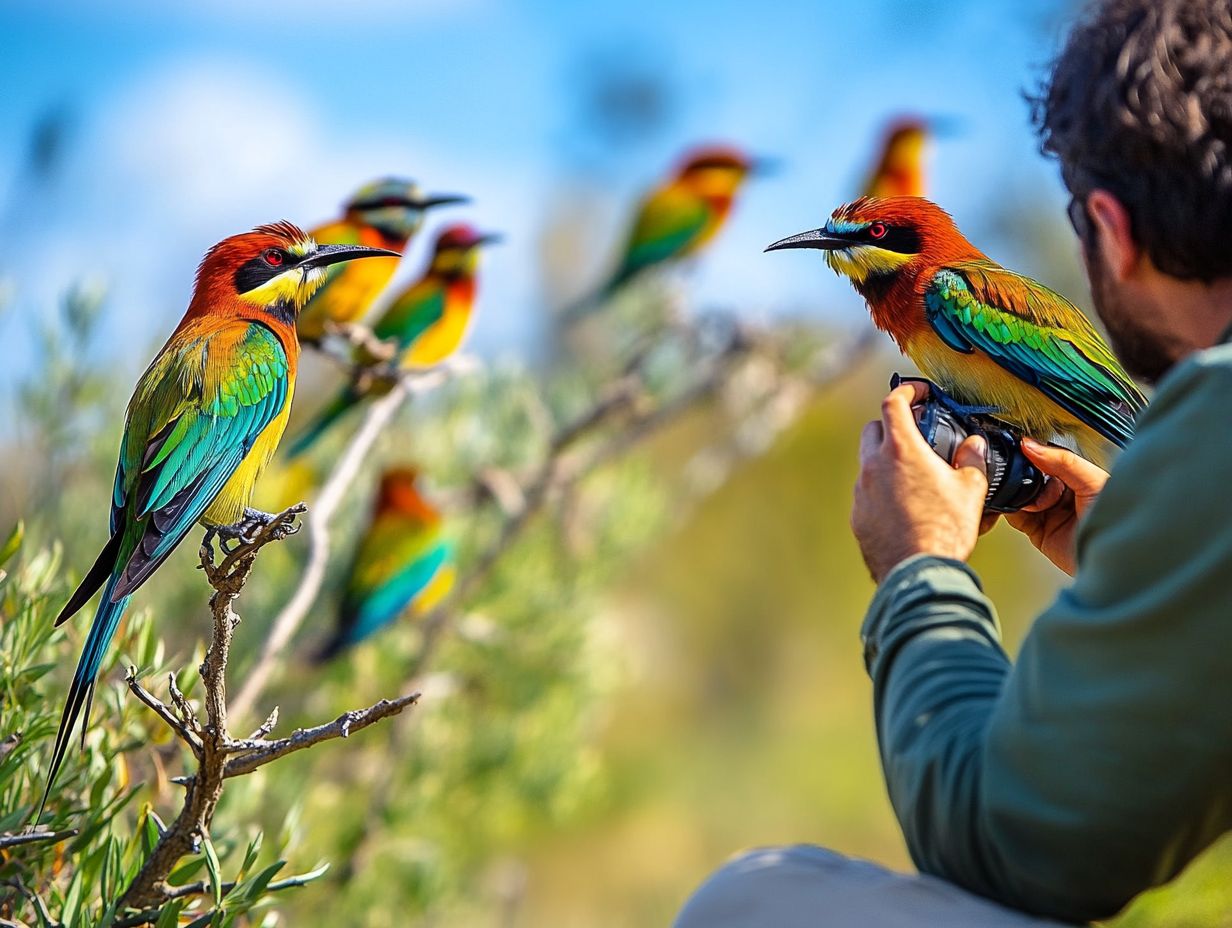
Some of the best online courses for bird photography include:
- “Bird Photography: From Beginner to Pro” on Udemy
- “Mastering Bird Photography” on CreativeLive
- “Bird Photography: From Snapshots to Great Shots” on KelbyOne
What skills can I learn from these online courses?
Unlock a treasure trove of skills! You ll learn bird identification, composition techniques, camera settings, and post-processing skills.
How can these courses benefit beginners in bird photography?
These courses are designed for beginners and provide a comprehensive introduction to bird photography, covering everything from equipment and techniques to the best photography workshops for birdwatchers and photographing different bird species.
Are there any specialized courses for specific bird species?
Yes, there are specialized courses for certain bird species, such as:
- “Bird Photography: Capturing Owls” on Udemy
- “Photographing Birds: The Hornbills of Borneo” on CreativeLive
These courses focus on the unique challenges and techniques for photographing these specific birds.
Do these courses offer any hands-on practice or feedback?
Some of these courses may offer hands-on practice and assignments to help you apply what you have learned. You can also share your photos and receive constructive criticism from a community or instructor feedback section.
Can I access these courses at any time?
Yes, these online courses are self-paced and can be accessed anytime, anywhere with an internet connection. This flexibility allows you to learn at your own pace and revisit the material as needed.
Don t miss out on these opportunities! Enroll now to elevate your bird photography skills.
Summary of Key Points:
- Avoid common mistakes in bird photography by understanding your camera settings.
- Utilize resources like online courses, books, and workshops to enhance your skills.
- Engage with the birding community for networking and inspiration.

